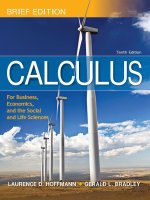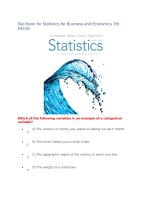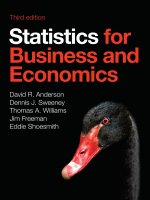Statistics for business economics 7th by paul newbold chapter 05
Bạn đang xem bản rút gọn của tài liệu. Xem và tải ngay bản đầy đủ của tài liệu tại đây (329.85 KB, 73 trang )
Statistics for
Business and Economics
7th Edition
Chapter 5
Continuous Random Variables
and Probability Distributions
Copyright © 2010 Pearson Education, Inc. Publishing as Prentice Hall
Ch. 5-1
Chapter Goals
After completing this chapter, you should be
able to:
Explain the difference between a discrete and a
continuous random variable
Describe the characteristics of the uniform and normal
distributions
Translate normal distribution problems into standardized
normal distribution problems
Find probabilities using a normal distribution table
Copyright © 2010 Pearson Education, Inc. Publishing as Prentice Hall
Ch. 5-2
Chapter Goals
(continued)
After completing this chapter, you should be
able to:
Evaluate the normality assumption
Use the normal approximation to the binomial
distribution
Recognize when to apply the exponential distribution
Explain jointly distributed variables and linear
combinations of random variables
Copyright © 2010 Pearson Education, Inc. Publishing as Prentice Hall
Ch. 5-3
Probability Distributions
Probability
Distributions
Ch. 4
Discrete
Probability
Distributions
Continuous
Probability
Distributions
Binomial
Uniform
Hypergeometric
Normal
Poisson
Exponential
Copyright © 2010 Pearson Education, Inc. Publishing as Prentice Hall
Ch. 5
Ch. 5-4
5.1
Continuous Probability Distributions
A continuous random variable is a variable that
can assume any value in an interval
thickness of an item
time required to complete a task
temperature of a solution
height, in inches
These can potentially take on any value,
depending only on the ability to measure
accurately.
Copyright © 2010 Pearson Education, Inc. Publishing as Prentice Hall
Ch. 5-5
Cumulative Distribution Function
The cumulative distribution function, F(x), for a
continuous random variable X expresses the
probability that X does not exceed the value of x
F(x) P(X x)
Let a and b be two possible values of X, with
a < b. The probability that X lies between a
and b is
P(a X b) F(b) F(a)
Copyright © 2010 Pearson Education, Inc. Publishing as Prentice Hall
Ch. 5-6
Probability Density Function
The probability density function, f(x), of random variable X
has the following properties:
1. f(x) > 0 for all values of x
2. The area under the probability density function f(x) over
all values of the random variable X is equal to 1.0
3. The probability that X lies between two values is the
area under the density function graph between the two
values
Copyright © 2010 Pearson Education, Inc. Publishing as Prentice Hall
Ch. 5-7
Probability Density Function
(continued)
The probability density function, f(x), of random variable X
has the following properties:
4. The cumulative density function F(x0) is the area under
the probability density function f(x) from the minimum
x value up to x0
x0
f(x 0 ) f(x)dx
xm
where xm is the minimum value of the random variable x
Copyright © 2010 Pearson Education, Inc. Publishing as Prentice Hall
Ch. 5-8
Probability as an Area
Shaded area under the curve is the
probability that X is between a and b
f(x)
P (a ≤ x ≤ b)
= P (a < x < b)
(Note that the probability
of any individual value is
zero)
a
Copyright © 2010 Pearson Education, Inc. Publishing as Prentice Hall
b
x
Ch. 5-9
The Uniform Distribution
Probability
Distributions
Continuous
Probability
Distributions
Uniform
Normal
Exponential
Copyright © 2010 Pearson Education, Inc. Publishing as Prentice Hall
Ch. 5-10
The Uniform Distribution
The uniform distribution is a probability
distribution that has equal probabilities for all
possible outcomes of the random variable
f(x)
Total area under the
uniform probability
density function is 1.0
xmin
Copyright © 2010 Pearson Education, Inc. Publishing as Prentice Hall
xmax x
Ch. 5-11
The Uniform Distribution
(continued)
The Continuous Uniform Distribution:
f(x) =
1
if a x b
b a
0
otherwise
where
f(x) = value of the density function at any x value
a = minimum value of x
b = maximum value of x
Copyright © 2010 Pearson Education, Inc. Publishing as Prentice Hall
Ch. 5-12
Properties of the
Uniform Distribution
The mean of a uniform distribution is
a b
μ
2
The variance is
2
(b
a)
σ2
12
Copyright © 2010 Pearson Education, Inc. Publishing as Prentice Hall
Ch. 5-13
Uniform Distribution Example
Example: Uniform probability distribution
over the range 2 ≤ x ≤ 6:
1
f(x) = 6 - 2 = .25 for 2 ≤ x ≤ 6
f(x)
μ
.25
a b 2 6
4
2
2
(b - a)2 (6 - 2)2
σ
1.333
12
12
2
2
6
Copyright © 2010 Pearson Education, Inc. Publishing as Prentice Hall
x
Ch. 5-14
5.2
Expectations for Continuous
Random Variables
The mean of X, denoted μX , is defined as the
expected value of X
μX E(X)
The variance of X, denoted σX2 , is defined as the
expectation of the squared deviation, (X - μX)2, of a
random variable from its mean
σ 2X E[(X μX )2 ]
Copyright © 2010 Pearson Education, Inc. Publishing as Prentice Hall
Ch. 5-15
Linear Functions of Variables
Let W = a + bX , where X has mean μX and
variance σX2 , and a and b are constants
Then the mean of W is
μW E(a bX) a bμX
the variance is
σ
2
W
2
Var(a bX) b σ
2
X
the standard deviation of W is
σW b σX
Copyright © 2010 Pearson Education, Inc. Publishing as Prentice Hall
Ch. 5-16
Linear Functions of Variables
(continued)
An important special case of the previous results is the
standardized random variable
X μX
Z
σX
which has a mean 0 and variance 1
Copyright © 2010 Pearson Education, Inc. Publishing as Prentice Hall
Ch. 5-17
5.3
The Normal Distribution
Probability
Distributions
Continuous
Probability
Distributions
Uniform
Normal
Exponential
Copyright © 2010 Pearson Education, Inc. Publishing as Prentice Hall
Ch. 5-18
The Normal Distribution
(continued)
‘Bell Shaped’
Symmetrical
Mean, Median and Mode
are Equal
Location is determined by the
mean, μ
Spread is determined by the
standard deviation, σ
The random variable has an
infinite theoretical range:
+ to
Copyright © 2010 Pearson Education, Inc. Publishing as Prentice Hall
f(x)
σ
μ
x
Mean
= Median
= Mode
Ch. 5-19
The Normal Distribution
(continued)
The normal distribution closely approximates the
probability distributions of a wide range of random
variables
Distributions of sample means approach a normal
distribution given a “large” sample size
Computations of probabilities are direct and elegant
The normal probability distribution has led to good
business decisions for a number of applications
Copyright © 2010 Pearson Education, Inc. Publishing as Prentice Hall
Ch. 5-20
Many Normal Distributions
By varying the parameters μ and σ, we obtain
different normal distributions
Copyright © 2010 Pearson Education, Inc. Publishing as Prentice Hall
Ch. 5-21
The Normal Distribution Shape
f(x)
Changing μ shifts the
distribution left or right.
σ
Changing σ increases
or decreases the
spread.
μ
x
Given the mean μ and variance σ we define the normal
distribution using the notation
X ~ N(μ,σ 2 )
Copyright © 2010 Pearson Education, Inc. Publishing as Prentice Hall
Ch. 5-22
The Normal Probability
Density Function
The formula for the normal probability density
function is
1
(x μ)2 /2σ 2
f(x)
e
2π
Where
e = the mathematical constant approximated by 2.71828
π = the mathematical constant approximated by 3.14159
μ = the population mean
σ = the population standard deviation
x = any value of the continuous variable, < x <
Copyright © 2010 Pearson Education, Inc. Publishing as Prentice Hall
Ch. 5-23
Cumulative Normal Distribution
For a normal random variable X with mean μ and
variance σ2 , i.e., X~N(μ, σ2), the cumulative
distribution function is
F(x 0 ) P(X x 0 )
f(x)
P(X x 0 )
0
Copyright © 2010 Pearson Education, Inc. Publishing as Prentice Hall
x0
x
Ch. 5-24
Finding Normal Probabilities
The probability for a range of values is
measured by the area under the curve
P(a X b) F(b) F(a)
a
Copyright © 2010 Pearson Education, Inc. Publishing as Prentice Hall
μ
b
x
Ch. 5-25









